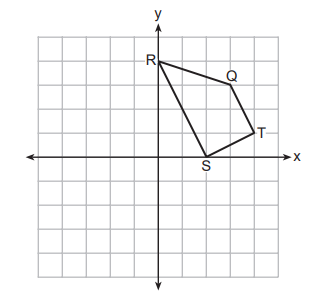Now that I'm caught up with the current New York State Regents exams, I'm revisiting some older ones.
More Regents problems.
Geometry Regents, January 2014
Part I: Each correct answer will receive 2 credits.
21. The coordinates of point P are (7,1). What are the coordinates of the
image of P after R90° about the origin?
1) (1, 7)
2) (-7, -1)
3) (1, -7)
4) (-1, 7)
Answer: 4) (-1, 7)
First thing to remember is if you are given a rotation, but not a direction, then the directionis counterclockwise. That is to say, the rotation is in the same order as the Quadrants I, II, III, IV.
Forget the formulas. Picture it in your head, or make a scratch drawing of the problem.
Choice (1) is in Quadrant I like the original point. It is a reflection over the line y = x.
Choice (2) is is Quadrant III. It is a 180 degree rotation, or a reflection across the origin.
Choice (3) is in Quandrant IV. It is a 90 degree clockwise rotation.
22. Lines p and q are intersected by line r, as shown below.
If m∠1 = 7x - 36 and m∠2 = 5x + 12, for which value of x would p || q?
1) 17
2) 24
3) 83
4) 97
Answer: 1) 17
The lines will be parallel if and only if angles 1 and 2 are supplementary. That is, they add up to 180 degrees.
So
7x - 36 + 5x + 12 = 180
12x - 24 = 180
12x = 204
x = 17
They want to know x, not the size of either angle, so you are done.
Note that if you wrote the equation 7x - 36 = 5x + 12 (assuming the angles were congruent when the illustration suggests that they may not be), then you would have gotten x = 24, which is Choice (2), and you wouldn't have known you made a mistake.
23. What is the equation of the circle with its center at (-1,2) and that
passes through the point (1,2)?
1) (x + 1)2 + (y - 2)2 = 4
2) (x - 1)2 + (y + 2)2 = 4
3) (x + 1)2 + (y - 2)2 = 2
4) (x - 1)2 + (y + 2)2 = 2
Answer: 1) (x + 1)2 + (y - 2)2 = 4
Once again, the formula for the equation of a circle is (x - h)
2 + (y - k)
2 = r
2, where (h, k) is the center of the circle, and r is the radius. Note that there are MINUS SIGNS in the formula.
The radius is the distance from (1, 2) to (-1, 2), which is 2 units. So r = 2, and r2 = 4. Eliminate Choices (3) and (4).
Since there are minus signs in the formula, we want (x + 1) and (y - 2) in the equation. That means Choice (2).
24. In the diagram below, diameter AB bisects chord CD at point E in circle F.
If AE = 2 and FB = 17, then the length of CE is
1) 7
2) 8
3) 15
4) 16
Answer: 2) 8
If AE = 2 and FB = 17, then AF = 17 and EF = 15. This is obviously NOT drawn to scale.
The length of CE = the length of ED because the diameter bisects it. Also, when a diameter bisects a chord, it intersects it perpendicularly, meaning that it creates right angles.
Since you know that the radius FB is 17, you can draw CF and DF and know that they also each have a length of 17.
Now you have two right triangles with a leg of 15 and a hypotenuse of 17. If you don't know your basic Pythagorean Triples (and you should!), you can use the Pythagorean Theorem
152 + x2 = 172
225 + x2 = 289
x2 = 64
x = 8
25.Which quadrilateral does not always have congruent diagonals?
1) isosceles trapezoid
2) rectangle
3) rhombus
4) square
Answer: 3) rhombus
You could sketch these are see that it's obvious that the rhombus does not have to have congruent diagonals. When it does have them, the rhombus is a square.
If the other cases, you can show through SAS that the diagonals create two congruent triangles. And therefore, the diagonals will be congruent because corresponding parts of congruent triangles are congruent.
More to come. Comments and questions welcome.
More Regents problems.



















































